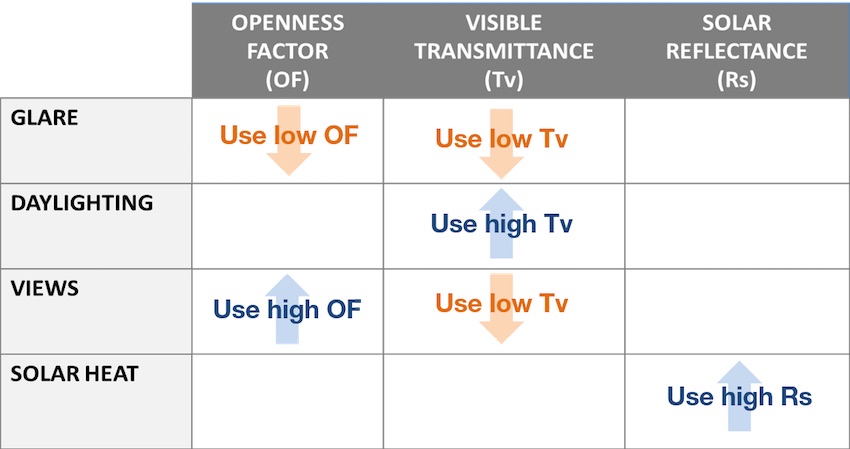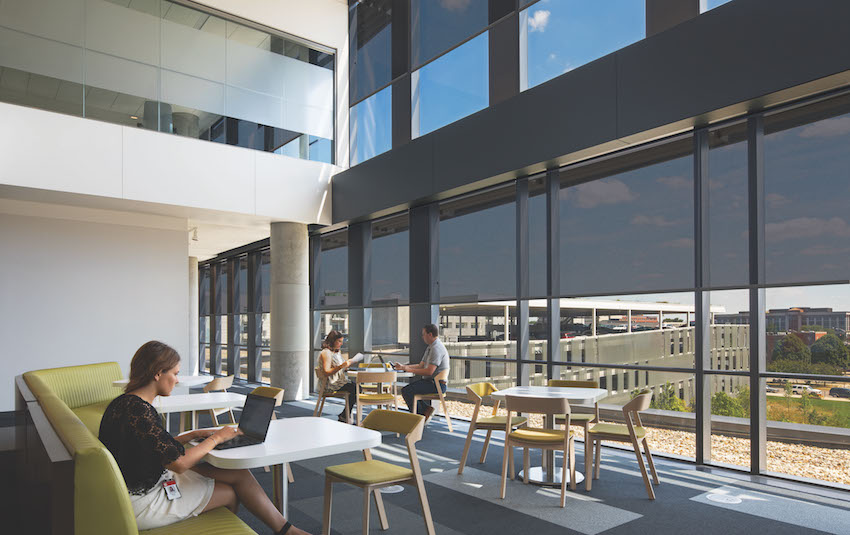Daylight Autonomy 101
Selecting the Right Daylight Management System
Luckily, designers have many options for managing the daylight that penetrates into a building's interior. There are permanent exterior and interior shading devices, like fixed overhangs and high-performance glazing, which provide constant glare control, but are limited in their ability to offer any variety in the amount of daylight protection they provide. As a result, these systems treat daylight on an overcast day and daylight on a sunny day as if it had equal opportunity to create glare, which it does not. In an attempt to protect the interior from damaging daylight, designers may, inadvertently, minimize the amount of usable daylight that is allowed into the work space, reducing the level of daylight autonomy that the building could achieve.
A shading system is a great example of a daylight management solution that offers enough flexibility to mitigate glare and heat gain when the outside daylight is intense and unusable, but maximize the penetration of usable daylight, when it is available. This variable level of daylight control makes a shading system a great tool to help a building reach its goal of daylight autonomy, without risking daylight exposures that would make the spaces unusable or uncomfortable. When selecting the right shading system for a project, the fabric is the key to mitigating glare and unusable daylight and the controllability is the key to achieving daylight autonomy and greater energy savings.

Image courtesy of Lutron
When specifying fabric, it is important to specify both the openness factor and Tv values of a shade fabric, and designers should be wary of manufacturers that list approximate openness factor values.
Specifying fabric. It is a common practice to select the fabric for a shading system based on its color, instead of based on how the shade will need to perform in terms of daylight management. While color can impact the view provided to the outside when the shades are deployed, for example, darker fabrics can provide a crisper view than lighter alternatives, selecting a shade based exclusively on its color compromises the ability of the shading system to prevent glare and maintain an optimal visual environment in the building. It can also negatively impact the aesthetic appeal that the shade color was intended to have in the first place. If the window is too bright to comfortably look at, no one will be able to appreciate the carefully selected color of the shade.
A shade manages solar energy in three ways: reflect it, absorb it or transmit it into the interior. The key to glare mitigation is limiting the visible transmittance of the daylight through the shade and into the visual environment, so that it stays within an acceptable brightness. In terms of achieving daylight autonomy, the daylight passing into a space should not exceed 200 fc in intensity.
In order to specify a shade fabric that will function as needed, it is important to understand that the shade does not work alone. Both the window glass and shade fabric impact the total visual transmittance of daylight together and must be considered in tandem to create a glass/fabric system that appropriately manages the available daylight throughout the year.
The glass used in most buildings today has a visual transmittance of 65 percent, allowing 65 percent of the light to pass through the glass and into the building. Fabric shades are most commonly available in visual transmittances ranging from 3 percent to 30 percent. If a building has standard, double-paned windows with a 65 percent transmittance, then on a sunny day where 3,000 fc of daylight is available, 1,950 fc will pass through the glass. If a shade fabric with a 10 percent visual transmittance is specified on these windows, then only 195 fc, of the 1,950 fc that were transmitted through the glass, will be ultimately transmitted into the interior space. A daylight level of 195 fc supports the design goals of achieving daylight autonomy and maintaining a comfortable visual environment. The shade fabric keeps the space comfortable and usable, even on a sunny day.
Typically, windows with higher visual transmittance values should be paired with fabrics that have lower transmittance values. Spaces that receive direct sunlight, such as the direct early morning light that an eastern exposure receives, should keep the combined transmittance of the glass and fabric to less than 10 percent. Areas without the threat of direct sun exposure can benefit from shades with higher transmittances to maximize the potential level of daylight autonomy it could achieve.
Specifying Controllability: Manual vs. Automated Shading Systems
Specifying the way that the shading system is controlled can have a powerful impact on the level of daylight autonomy that a building is able to achieve. The controllability of shading systems can be divided into two categories: manual and automated. While the shades in either system can be made from identical fabrics and similarly positioned at any height, a person must physically deploy or retract the shade fabric of each shade in a manual system. Automated shades are programmed to move into their different positions throughout the day in response to a pre-determined schedule or in response to sensors that measure the intensity of the daylight at the window. No manual manipulation is necessary to ensure that glare conditions are being prevented and usable daylight is allowed in.
Manual Shading System and Daylight Autonomy
The primary challenge that a building equipped with a manual shading system will face, when attempting to achieve daylight autonomy, is reliably letting in diffuse, ambient daylight, when available. People are relatively proficient in closing the shades to relieve a space from glaring or uncomfortable conditions, however, they are not as diligent at opening the shades back up, when the daylight transforms from direct to diffuse. It is quite normal for a shade to be pulled down to block harsh, direct light and then left down for days, months or longer. A window with a manual shade deployed over it, day after day, protects the space from glare, but it limits the usable daylight allowed into the interior and significantly reduces the space's ability to exclusively illuminate the space with daylight.
Automated Shading Systems and Daylight Autonomy
An automated shading system is a powerful tool for a building trying to achieve daylight autonomy. These systems are dedicated to managing the dynamic and ever-changing nature of daylight, every day, all day long. The automated shading systems use the solar path of the sun as it arcs over the building to determine the optimal position of the shade and continuously adjust the position to accommodate the changing solar angles. The adjustments reliably block direct sunlight, while allowing usable daylight into the building. These systems also have sensors placed near the windows that can detect the level of daylight in the space and adjust accordingly, keeping shades deployed on overly bright days and retracting shades on overcast days to allow the soft, diffuse daylight into the building.
Here is an example of how an automated shading system in a glass-clad building may function throughout the day. As the sun rises, the shades on the eastern exposure may deploy to a position halfway down the window to block early morning light, while the shades on the northern, southern and western exposures may be entirely retracted, to let in the gentle morning light. As the morning progresses, the shades on the eastern exposure may lower to a full closed position, while the shades on the northern and southern exposure deploy to one-fourth of the way down the window, and the shades on the western façade remain fully open. As it approaches noon, the shades on the eastern exposure retract to halfway position, while the shades on the southern exposure are deployed to the halfway position and the western exposure shades lower to cover the top fourth of the window. In early afternoon, the shades on the eastern exposure are retracted completely, letting in the available afternoon light and the shades on the southern and western sides deploy further to block the direct light as the day progresses. At sunset, all of the shades are fully open, allowing occupants to enjoy the soft light of early evening. Automated shades move silently and automatically through all of these position changes, without requiring any manual manipulation. It should also be mentioned that automated shading systems move shades to precise, aligned levels along a façade, maintaining the curb appeal of the building, while maximizing the daylight autonomy of the interior.

Photo: © Chris Cooper
The automated shading system in the Cummins Distribution Headquarters in Indianapolis moves every shade to a precise position, keeping the hembars aligned along the window wall.
“Our firm was recently hired to compare the daylight autonomy that could be achieved with manual shades and automated shades on a large, corporate campus,” Bailey said. “Our analysis concluded that automated shades significantly increased the DA factor of the building and provided additional energy savings. The owner also installed daylight responsive controls throughout the project which reduced the building's overall dependence on electric energy.”
When deciding which shading system to specify, the most common challenge to selecting an automated system is the cost, however, the attitude is changing as the benefits of daylight exposure and daylight autonomy become more widely accepted and valued. As Jack Bailey experienced on a recent project, “The owner of this particular project knew how much they were spending to install glass curtain walls around the buildings. The added cost of an automated shading system was not significant when compared to the cost of the windows. From the owner's perspective, this automated system allowed the building to make better use of the windows and provided access to improved daylight and views for a small up-charge. It made a lot of sense to them.”









